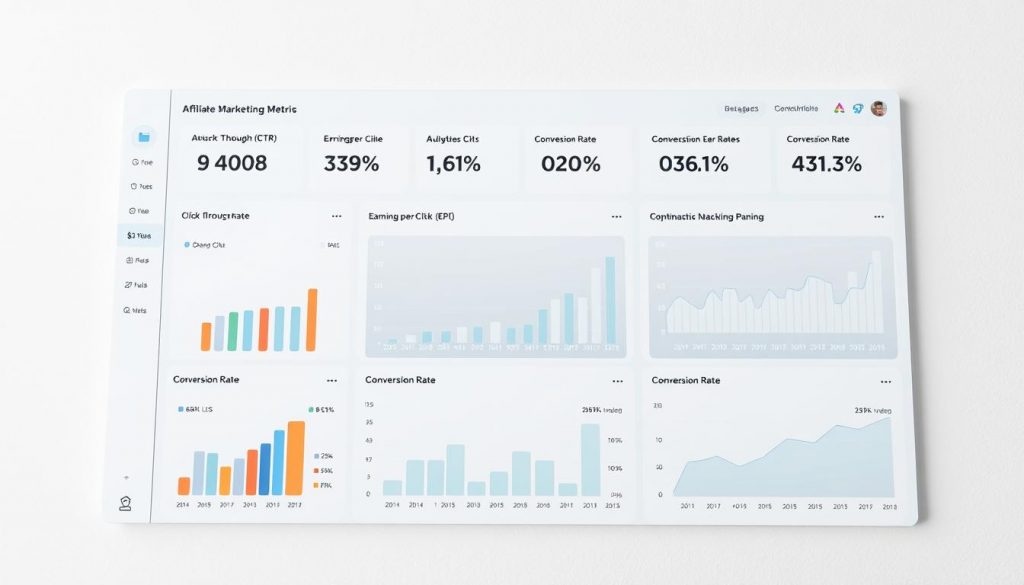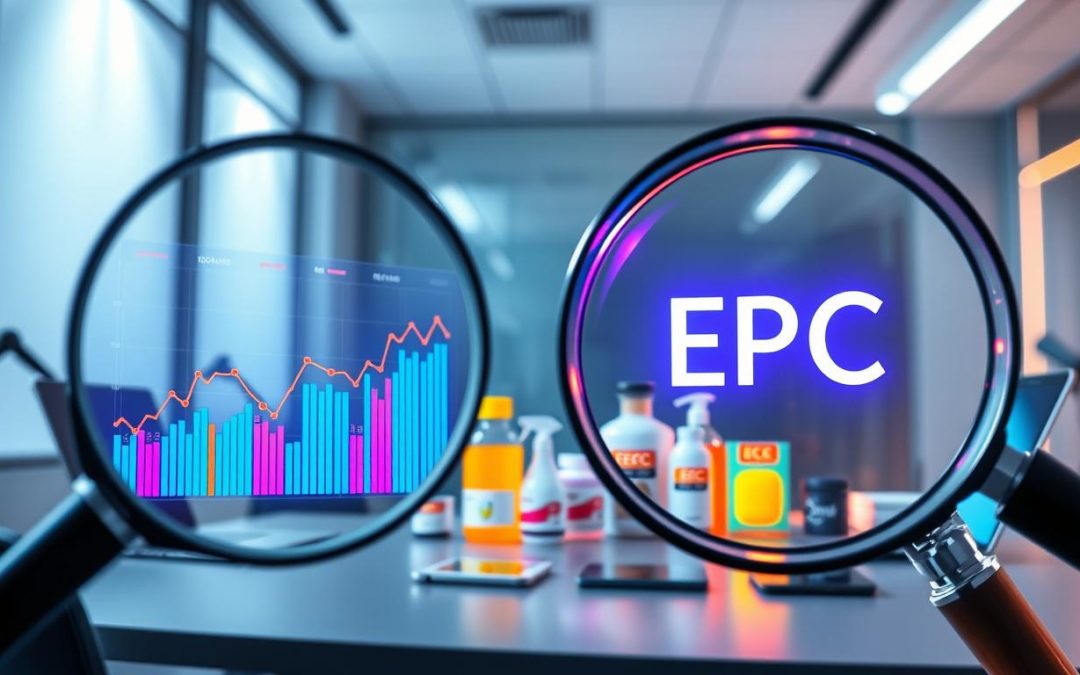Table of Contents
Have you ever wondered how successful affiliate marketers consistently maximize their profits? The secret lies in understanding and optimizing a key metric: Earnings Per Click (EPC). This simple yet powerful tool helps marketers make data-driven decisions, ensuring their campaigns are as profitable as possible.
EPC is calculated by dividing the total commissions earned by the number of clicks on affiliate links. For example, if a campaign generates $100 from 50 clicks, the EPC would be $2.00. This metric allows us to gauge the effectiveness of our strategies and choose the most lucrative affiliate products.
Real-world examples, like OptinMonster campaigns, show how targeted popups can boost affiliate sales by 30%. By using techniques such as Exit-Intent® Technology, marketers can achieve a click-through rate of 17.31%, significantly improving their EPC.
But how can you apply these strategies to your own campaigns? This guide will walk you through the mechanics, benefits, and actionable steps to optimize your EPC. Ready to take your affiliate marketing to the next level?
Key Takeaways
- EPC is a vital metric for measuring affiliate campaign profitability.
- It’s calculated by dividing total earnings by the number of clicks.
- Targeted campaigns, like OptinMonster, can significantly boost EPC.
- Understanding EPC helps in choosing the right affiliate products.
- Optimizing landing pages and using A/B testing can improve EPC.
Understanding EPC (Earnings Per Click)
One of the most important metrics in affiliate marketing is often overlooked. This metric helps us measure the effectiveness of our campaigns and make data-driven decisions. Let’s dive into what it is, why it matters, and how to calculate it.
Definition and Core Concept
This metric represents the average amount earned for each click on affiliate links. It’s a simple yet powerful way to gauge the performance of your campaigns. For example, if you earn $100 from 50 clicks, the metric would be $2.00.
Understanding this concept is crucial for both beginners and seasoned marketers. It helps us identify which campaigns are profitable and which need improvement. As the saying goes, “What gets measured gets managed.”
Calculation Methods and Real-Life Examples
Calculating this metric is straightforward. Divide the total commissions by the number of clicks. For instance, $1,000 in commissions from 500 clicks results in a metric value of $2.
Here’s a comparison of three different campaigns:
| Campaign | Impressions | Clicks | Income | Metric Value |
|---|---|---|---|---|
| Offer #1 | 300,000 | 2,000 | $100 | $0.05 |
| Offer #2 | 300,000 | 500 | $60 | $0.12 |
| Offer #3 | 300,000 | 4,000 | $150 | $0.038 |
Tracking this metric over time, such as weekly or monthly, provides deeper insights into campaign performance. For example, a 33% increase in revenue can be achieved when the metric rises from $2 to $3, even without additional traffic.
To learn more about optimizing your campaigns, check out this comprehensive guide. Additionally, improving your on-page optimization can further enhance your results.
Why EPC Matters in Affiliate Marketing
In the competitive world of affiliate marketing, understanding key metrics can make or break your success. One metric stands out for its direct impact on revenue: Earnings Per Click (EPC). It’s not just about driving traffic; it’s about ensuring that every click counts toward your bottom line.

Comparing EPC with Other Key Metrics
While metrics like CPC (Cost Per Click) and conversion rates are important, EPC offers a clearer picture of profitability. CPC measures how much you pay for each click, but it doesn’t tell you how much you earn. Conversion rates show how many clicks turn into sales, but they don’t account for the value of those sales. EPC, on the other hand, combines both factors to show the average earnings per click.
For example, if you earn $200 from 20 clicks, your EPC is $10. This metric helps us identify which affiliate links are truly profitable and which need improvement.
Impact on Profitability and ROI
Focusing on higher EPC products can significantly boost your revenue and ROI. High EPC indicates that your affiliate links are generating substantial commissions, even with fewer clicks. This is especially important in competitive industries like finance and healthcare, where an EPC above $2 or $3 is considered robust.
Here’s a comparison of EPC across different industries:
| Industry | Average EPC |
|---|---|
| Tech Software | $25 |
| Health & Wellness | $18 |
| Financial Services | $30 |
| Luxury E-commerce | $40 |
| Premium Travel | $35 |
Monitoring EPC weekly allows us to make timely adjustments and stay ahead of trends. For instance, a well-optimized landing page can boost EPC by converting clicks into commissions.
By understanding and optimizing EPC, we can navigate complex affiliate networks more effectively and maximize our earnings. It’s not just about driving traffic; it’s about driving the right traffic to the right affiliate links.
Strategies for Increasing Your EPC
Boosting your affiliate revenue requires more than just traffic—it’s about smart strategies. By focusing on tactics that engage users at the right moment, we can significantly improve our results. Let’s explore some proven methods to enhance your campaigns.
Targeted Popups and Timed Campaigns
One of the most effective ways to capture attention is through targeted popups. Exit-intent technology, for example, detects when a user is about to leave and displays a relevant offer. This strategy has been shown to increase click-through rates by 17.31%.
Timed campaigns are another powerful tool. By displaying a popup after a user spends a specific amount of time on a page, we can reinforce the affiliate offer without being intrusive. This approach ensures that the message reaches users when they’re most engaged.

Content Alignment and Non-Intrusive Floating Bars
Aligning your content with affiliate offers is crucial for success. When users find value in the content, they’re more likely to click on the embedded links. For instance, a blog post about fitness tips can seamlessly integrate affiliate links to workout gear.
Non-intrusive floating bars are another excellent option. These bars provide essential information about affiliate products without disrupting the user experience. They’re particularly effective for promoting limited-time offers or discounts.
To optimize these strategies, A/B testing is essential. By experimenting with different designs, messaging, and timing, we can identify what resonates best with our audience. This data-driven approach ensures that every campaign is as effective as possible.
As marketers, we must continually innovate our strategies to adapt to evolving user behavior. By combining these tactics, we can maximize our affiliate success and drive meaningful results.
Optimizing Affiliate Campaigns with Targeted Tools
To truly excel in affiliate marketing, leveraging the right tools is essential. These tools help us tailor campaigns to specific audiences, ensuring every click affiliate drives meaningful results. By focusing on targeted strategies, we can maximize conversions and build a stronger network of affiliate partners.
Leveraging OptinMonster Features Effectively
OptinMonster offers a comprehensive suite of tools designed to enhance affiliate campaigns. Its pre-built templates and exit-intent technology have been shown to increase conversions by 17.31%. These features allow us to engage users at the right moment, ensuring our product messaging resonates.
For example, geo-targeting enables us to deliver location-specific offers, while onsite retargeting keeps users engaged with relevant content. These strategies ensure we’re reaching the right customer at the right time, boosting overall performance.
Utilizing Geo-targeting and Onsite Retargeting
Geo-targeting is a powerful way to customize campaigns based on user location. By tailoring offers to specific regions, we can increase the relevance of our link placements. Onsite retargeting, on the other hand, helps re-engage users who have shown interest but haven’t converted yet.
These tools work together to create a seamless experience, ensuring users see the most relevant offers at every stage of their journey. This approach not only improves conversions but also strengthens our relationship with affiliate partners.
Customizing Campaigns for Higher Conversions
Customization is key to successful affiliate campaigns. By tailoring templates and messaging to specific affiliate partners, we can enhance click-through rates and drive higher conversions. A/B testing different elements, such as headlines and CTAs, helps us identify what works best.
For instance, a well-designed landing page with clear product messaging can significantly increase the amount of commission per click. By continuously refining our tactics, we ensure our campaigns remain effective and profitable.
In conclusion, targeted tools like OptinMonster, geo-targeting, and retargeting are essential for optimizing affiliate campaigns. By focusing on customization and relevance, we can drive higher conversions and build a stronger affiliate network.
Data-Driven Decisions: Testing and Performance Metrics
Making informed decisions in affiliate marketing requires a solid foundation of data and testing. By analyzing performance metrics, we can optimize campaigns and maximize results. Let’s explore how A/B testing and tracking key metrics can drive success.
A/B Testing for Optimized Landing Pages
A/B testing is a powerful tool for refining landing pages. By comparing two versions of a page, we can identify which design, messaging, or call-to-action performs better. For example, changing a headline or button color can significantly impact conversion rates.
This method allows us to make data-driven adjustments, ensuring every element resonates with our audience. Over time, these small changes can lead to substantial improvements in campaign performance.
Tracking and Analyzing Key Marketing Metrics
Tracking metrics like click-through rates (CTR) and conversion rates (CR) is essential for understanding campaign effectiveness. A high CTR indicates engaging content, while a strong CR suggests effective targeting.
Other metrics, such as average order value (AOV) and return on investment (ROI), help us gauge profitability. By monitoring these numbers, we can allocate resources more efficiently and focus on high-performing strategies.
Working as a team and utilizing the right resources ensures we make informed decisions. Tools like Google Analytics and ClickMeter provide detailed insights, helping us stay ahead of trends.
Ultimately, data-driven decisions are integral to our continuous improvement. By measuring and analyzing performance, we can refine our strategies and achieve long-term success in affiliate marketing. For more insights, check out this comprehensive guide on key performance indicators.
Conclusion
Understanding and optimizing key metrics can transform your affiliate marketing results. By focusing on the value of each click affiliate link, we ensure every effort contributes to higher conversions and revenue. This guide has highlighted actionable strategies, from targeted campaigns to data-driven testing, that empower us to make smarter decisions.
Tracking performance metrics like EPC helps us identify what works and what needs improvement. For example, campaigns with higher EPC generate more revenue, even with fewer clicks. Tools like OptinMonster and A/B testing further enhance our ability to engage users effectively.
Implementing these strategies is the way to achieve measurable success. Every click matters, and by refining our approach, we can maximize our affiliate marketing potential. Start applying these tactics today and see the difference in your results.
FAQ
What is Earnings Per Click (EPC)?
Earnings Per Click (EPC) is a metric used in affiliate marketing to measure the average income generated from each click on an affiliate link. It helps marketers understand the effectiveness of their campaigns.
How do I calculate EPC?
To calculate EPC, divide the total earnings generated from an affiliate link by the total number of clicks on that link. This gives you the average income per click.
Why is EPC important in affiliate marketing?
EPC is crucial because it provides insights into the profitability of your campaigns. It helps you compare different strategies and optimize your efforts for better returns.
How can I increase my EPC?
You can increase your EPC by using targeted popups, timed campaigns, and aligning your content with the affiliate products. Non-intrusive floating bars and geo-targeting also help improve performance.
What tools can help optimize my affiliate campaigns?
Tools like OptinMonster offer features such as geo-targeting, onsite retargeting, and customizable campaigns. These tools help you create more effective strategies for higher conversions.
How do I track the performance of my affiliate campaigns?
Use A/B testing to optimize landing pages and track key metrics like conversion rates and click-through rates. Analyzing these metrics helps you make data-driven decisions.
Can EPC vary between different affiliate programs?
Yes, EPC can vary based on the commission structure, product value, and the quality of traffic. It’s important to choose programs that align with your audience and goals.
What is the difference between EPC and CPC?
EPC measures earnings generated per click, while CPC (Cost Per Click) refers to the cost advertisers pay for each click. EPC focuses on revenue, whereas CPC focuses on expenses.
Source Links
- Earnings Per Click: How to Win Big at Affiliate Marketing – OptinMonster – https://optinmonster.com/earnings-per-click-affiliate-marketing/
- What is EPC Earnings (Earnings Per Click)? | Leadpages – https://www.leadpages.com/blog/what-is-epc-earnings-per-click-and-how-to-calculate-epc-2?srsltid=AfmBOop8-bgooJlB80s3XI0OyfTXgf_7rWAvXME0ob0wNUTemWKd1xiR
- Earnings Per Click: What Does EPC Mean in Affiliate Marketing? – CrakRevenue – https://www.crakrevenue.com/blog/epc-in-affiliate-marketing/
- What Does EPC Mean in Affiliate Marketing and Why It Matters? – https://medium.com/@nrichardbiz_91133/what-does-epc-mean-in-affiliate-marketing-and-why-it-matters-aafe563f44b3
- What is EPC in Affiliate Marketing & How to Boost Your EPC – https://www.optimonk.com/what-is-epc-in-affiliate-marketing/
- Unlock Your Affiliate Marketing Potential: What Is EPC in Affiliate Marketing and How to Maximize Your Earnings – Advertise Purple – https://www.advertisepurple.com/what-is-epc-in-affiliate-marketing/
- Earnings Per Click | How Affiliates Partners Can Improve EPCs – https://www.performcb.com/content-hub/how-to-improve-epc-in-affiliate-marketing/
- What is EPC (Earnings Per Click) in affiliate marketing, and how can it be improved? – https://www.hostinger.com/tutorials/what-is-epc-in-affiliate-marketing
- Earnings per Click (EPC) – https://seo.ai/faq/earnings-per-click-epc
- Using Affiliate Marketing Metrics to Boost ROI – Freedom to Ascend – https://www.freedomtoascend.com/marketing/marketing-channels/affiliate-marketing/affiliate-marketing-metrics/
- Why Tracking Earnings Per Click Is Important to Affiliates – https://www.tune.com/blog/3-tips-for-earnings-per-click-campaigns/
- 21 Affiliate Marketing Benchmarks & KPIs | Partnero – https://www.partnero.com/articles/21-essential-affiliate-marketing-benchmarks–kpis-for-success-in-2025
- Earnings Per Click: What is EPC in Affiliate Marketing — Claspo.io – https://claspo.io/blog/earnings-per-click-what-is-epc-in-affiliate-marketing/
- EPC in affiliate marketing & HOW to make the most from it – https://bixgrow.com/epc-in-affiliate-marketing/
